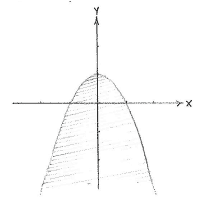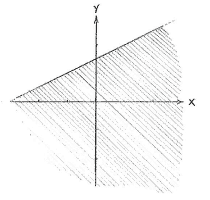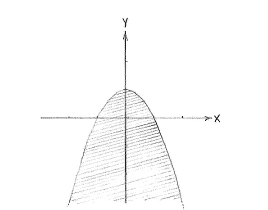Lösung 2.3:10b
Aus Online Mathematik Brückenkurs 1
K (hat „Solution 2.3:10b“ nach „Lösung 2.3:10b“ verschoben: Robot: moved page) |
|||
| Zeile 1: | Zeile 1: | ||
| - | + | Die Ungleichung <math>y\le 1-x^{2}</math> definiert das Gebiet unter der Parabel | |
| - | <math>y=1-x^{2}</math> | + | <math>y=1-x^{2}</math>. Die andere Ungleichung <math>x\ge 2y-3</math> können wir wie <math>y\le x/2+3/2</math> schreiben, und daher definiert sie das Gebiet Unter der Gerade <math>y=x/2+3/2</math>. |
| Zeile 13: | Zeile 13: | ||
|} | |} | ||
| - | + | Es scheint so zu sein, als liegt die Gerade ganz oberhalb der Parabel. Dies würde bedeuten dass die Ungleichung <math>y\le 1-x^{2}</math> auch die Ungleichung <math>y\le x/2+3/2</math> erfüllt. | |
| - | + | ||
| Zeile 23: | Zeile 22: | ||
|} | |} | ||
| - | + | Wir kontrollieren ob so auch der Fall ist, nämlich ob der ''y''-Wert der Gerade immer größer als der ''y''-Wert der Parabel für denselben ''x''-Wert ist. Wir betrachten den Unterschied | |
| - | + | ||
{{Abgesetzte Formel|| | {{Abgesetzte Formel|| | ||
<math>y_{\scriptstyle\text{line}} - y_{\scriptstyle\text{parabola}} = \frac{x}{2} + \frac{3}{2} - (1-x^{2})\,\textrm{.}</math>}} | <math>y_{\scriptstyle\text{line}} - y_{\scriptstyle\text{parabola}} = \frac{x}{2} + \frac{3}{2} - (1-x^{2})\,\textrm{.}</math>}} | ||
| - | + | Durch ein wenig Vereinfachungen erhalten wir | |
{{Abgesetzte Formel||<math>\begin{align} | {{Abgesetzte Formel||<math>\begin{align} | ||
| - | y_{\scriptstyle\text{ | + | y_{\scriptstyle\text{Gerade}} - y_{\scriptstyle\text{Parabel}} |
&= \frac{x}{2} + \frac{3}{2} - (1-x^{2})\\[5pt] | &= \frac{x}{2} + \frac{3}{2} - (1-x^{2})\\[5pt] | ||
&= x^{2}+\frac{1}{2}x+\frac{1}{2}\\[5pt] | &= x^{2}+\frac{1}{2}x+\frac{1}{2}\\[5pt] | ||
| Zeile 39: | Zeile 37: | ||
\end{align}</math>}} | \end{align}</math>}} | ||
| - | + | Wir sehen hier dass der Ausdruck immer positiv ist, nachdem <math>\tfrac{7}{16}</math> positiv ist, und <math>\bigl(x+\tfrac{1}{4}\bigr)^{2}</math> immer größer als, oder gleich null ist. Also liegt die Parabel ganz unterhalt der Gerade. | |
Version vom 21:02, 16. Mär. 2009
Die Ungleichung \displaystyle y\le 1-x^{2} definiert das Gebiet unter der Parabel \displaystyle y=1-x^{2}. Die andere Ungleichung \displaystyle x\ge 2y-3 können wir wie \displaystyle y\le x/2+3/2 schreiben, und daher definiert sie das Gebiet Unter der Gerade \displaystyle y=x/2+3/2.
| The region y ≤ 1 - x² | The region x ≥ 2y - 3 |
Es scheint so zu sein, als liegt die Gerade ganz oberhalb der Parabel. Dies würde bedeuten dass die Ungleichung \displaystyle y\le 1-x^{2} auch die Ungleichung \displaystyle y\le x/2+3/2 erfüllt.
| The region y ≤ 1 - x² and x ≥ 2y - 3 |
Wir kontrollieren ob so auch der Fall ist, nämlich ob der y-Wert der Gerade immer größer als der y-Wert der Parabel für denselben x-Wert ist. Wir betrachten den Unterschied
|
\displaystyle y_{\scriptstyle\text{line}} - y_{\scriptstyle\text{parabola}} = \frac{x}{2} + \frac{3}{2} - (1-x^{2})\,\textrm{.} |
Durch ein wenig Vereinfachungen erhalten wir
| \displaystyle \begin{align}
y_{\scriptstyle\text{Gerade}} - y_{\scriptstyle\text{Parabel}} &= \frac{x}{2} + \frac{3}{2} - (1-x^{2})\\[5pt] &= x^{2}+\frac{1}{2}x+\frac{1}{2}\\[5pt] &= \Bigl(x+\frac{1}{4}\Bigr)^{2} - \Bigl(\frac{1}{4}\Bigr)^{2} + \frac{1}{2}\\[5pt] &= \Bigl(x+\frac{1}{4}\Bigr)^{2} + \frac{7}{16} \end{align} |
Wir sehen hier dass der Ausdruck immer positiv ist, nachdem \displaystyle \tfrac{7}{16} positiv ist, und \displaystyle \bigl(x+\tfrac{1}{4}\bigr)^{2} immer größer als, oder gleich null ist. Also liegt die Parabel ganz unterhalt der Gerade.



